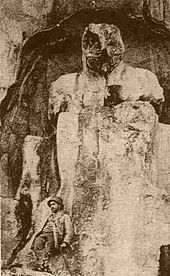Manisa rock relief
The rock relief of Manisa , also rock relief of Akpınar , Turkish Taş Suret (rock painting ) or Sipil Heykeli (Sipylos monument) , known as the Kybele relief , is located in the suburb Akpınar about 5 km east of the Turkish provincial capital Manisa above an amusement park on the road to Salihli . It represents a Hittite god figure.
Coordinates: 38 ° 35 ′ 52 ″ N , 27 ° 30 ′ 0 ″ E
The relief
The rock relief lies at a height of 100 to 120 m in a granite slope of the Sipylos Mountains and overlooks the city of Manisa, the ancient Lydian magnesia on the Sipylos and the valley of the Gediz (in ancient Hermos) . It is over 6 m high and in a poor state of preservation. Depicted in high relief , but not completely separated from the rock, is a seated figure who looks straight ahead to the north and is wearing a high, pointed headgear. The hands seem to be on the chest, the feet are on a stool. The height of the figure is 4.3 meters. To the right of the head remains of two hieroglyphic Luwian inscriptions can be seen, which, in connection with other features, suggest a date in the Hittite Empire. Cecil John Cadoux dates back to the time of Šuppiluliuma I or his son Muršili II , i.e. the 14th century BC. For likely. Helmuth Theodor Bossert read the left of the two inscriptions (Akpınar 1) in relief as Prince Kuwalanamuwa , the same name that appears on the Hanyeri rock relief , although it is unclear whether it is the same person. The right incised inscription (Akpınar 2) could not be read by Hans Gustav Güterbock , who studied the relief together with RA Alexander in 1978.
reception
Pausanias sees the figure in his description of Greece as mother goddess and a work of Broteas , son of Tantalus . Numerous travelers of the 18th and 19th centuries describe the work, including Richard Chandler , Charles Texier , Gustav Hirschfeld and Archibald Henry Sayce . The interpretation of the figure is controversial. Kurt Bittel rejects the identification of Bossert with Cybele as undetectable, but nevertheless sees a female god figure , also Ekrem Akurgal . Peter Z. Spanos, on the other hand, sees the figure as a weather god, the general tendency today is to interpret the image as a male deity, probably a mountain god.
In connection with another, natural rock formation near Manisa, which resembles a seated figure and is called the Weeping Niobe , the name Niobe rock is also incorrectly used for this relief .
literature
- Kay Kohlmeyer : Rock paintings from the Hittite Empire. In: Acta Praehistorica et Archaeologica 15 (1983) pp. 28-34.
- Peter Z. Spanos: Some comments on the so-called Niobe monument near Manisa (Magnesia ad Sipylum). In: Contributions to the ancient world of Asia Minor. Festschrift for Kurt Bittel. Zabern, Mainz 1983, pp. 477-483.
- Maarten J. Vermaseren : Corpus Cultus Cybelae Attidisque (CCCA) Volume 1: Asia Minor (= Etudes préliminaires aux religions orientales dans l'Empire Romain Vol. 50, 1). Brill, Leiden et al. 1987, ISBN 90-04-05399-9 , p. 129, at GoogleBooks .
- Horst Ehringhaus : gods, rulers, inscriptions. The rock reliefs of the Hittite Empire in Turkey. Zabern, Mainz 2005, ISBN 3-8053-3469-9 , pp. 84-87.
Web links
Individual evidence
- ↑ Cecil John Cadoux: Ancient Smyrna. A history of the city from the earliest times to 324 AD Blackwell, Oxford 1938, pp. 25-26.
- ↑ a b c Horst Ehringhaus: Gods, rulers, inscriptions. 2005, p. 87.
- ↑ Pausanias 3, 22, 4 English translation .
- ↑ Kurt Bittel: Kubaba - Kybele. In: Erich Ebeling , Bruno Meissner , Dietz-Otto Edzard (Hrsg.): Reallexikon der Assyriologie and Near Eastern Archeology . Volume 6: Lamentation - Lebanon. Walter de Gruyter, Berlin 1983, ISBN 3-11-010051-7 , p. 264, at GoogleBooks .



